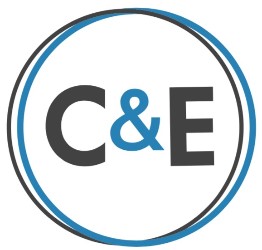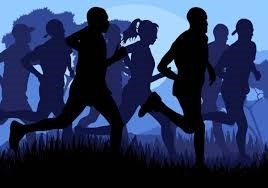
Pilates, which has gained much attention in recent years but in fact originated nearly a century ago, has a strong focus on stability and balance and is becoming increasingly popular with runners. The question is, why? The connections between a marathoner on the move and a Pilates mat workout that takes place largely on the floor may be not be immediately obvious. But the fact is, runners can seriously benefit by integrating Pilates into their lives – here are just seven benefits runners can get from practicing Pilates.
1. EFFICIENCY
Pilates helps you run more efficiently downhill with a stronger and more balanced sciatic area, as well as run more efficiently uphill with a stabilized musculature. Many of the moves in Pilates focus on upper back extension and rotation improvement movements. These help open up and mobilize the thoracic spine (upper / mid-back), which helps keep you upright. Consider for a moment all the sitting or hunching you do on a daily basis, whether rounded over a desk and computer, driving, or sitting in front of the TV. Pilates helps improve the extension and rotation of the thoracic spine by loosening tight muscles and increasing your range of motion. Your spine needs to be able to rotate well to counterbalance your stride. A comprehensive Pilates workout always includes spinal mobility.
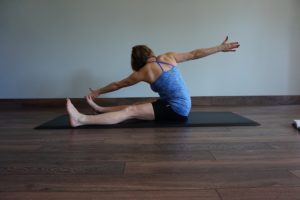 |
Exercise (left): The Saw With your core pulled in, reach your left arm to the outside edge of your right foot (or as close as you can get it). Exhale, and repeat on the other side. Try to keep your legs straight. If you can’t, bring the legs closer together and work to widen them over time. Do this exercise four times on each side. WHY: Stretches the hamstrings and the quadratus lumborum muscle, which is responsible for lifting the hip as you swing forward into your stride. |
2. BACK STRENGTH
You may think that running only focuses on the lower body, however, maintaining proper form requires total body strength and flexibility. Do you find yourself slouching during your run? Many do when you get tired, resulting in restricted breathing. You may be comprising your lower body alignment, and that can result in lower back pain. Learning to keep your head and neck in a neutral position will help you improve upper body movement and reduce fatigue. Pilates instructors are trained to be aware and mindful of alignment constantly through your practice, elongating you and aligning your spine for better stability, building up the back muscles evenly.
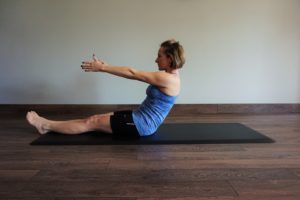 |
Exercise(left): The Roll Up Do this movement slowly and carefully with control. Each vertebra of the spine should lift off the ground one at a time. Take at least one full breath to roll up. On another breath, reverse and roll down with control, returning one vertebra at a time. Repeat five times. WHY: Loosens up and elongates the lower back, hamstrings, and calves. Also improves core strength. |
3. BREATH
Pilates helps you learn to expand the diaphragm and enhance your concentration through focused breathing. For runners, this helps increase oxygenation and stamina with a diaphragm that is able to fully expand. By opening up your chest, not only are you giving your body a chance at more efficient respiration, you are also increasing your arm swing range of motion. Efficient breathing is a key component of Pilates practice, and you will learn to use your breath as a tool within your movement.
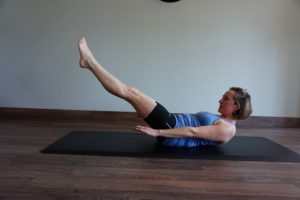
Exercise (left): The ‘100
Do a cycle of 10 full breaths while fluttering your hands at your side up and down—each breath includes five counts of inhalation and five counts of exhalation. After you do 10 complete breaths, you will have completed 100 arm pumps.
WHY: Teaches controlled breathing, so that your inhales and exhales are balanced. Bonus: Builds strong abdominals.
Exercise: The ‘Swan’
As you exhale, slowly lower yourself back down, chest first, then shoulders, neck, chin, and head. To avoid discomfort in your back, concentrate on pulling your shoulders back to open up your chest. Repeat 10 times.
WHY: Opens up the chest and deepens your lung capacity to correct shallow breathing.
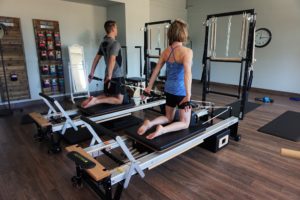 |
Exercise (left): The Chest Extension (On Knees or Standing) WHY: Stretches the intercostal muscles (which lie between the ribs), relaxes the shoulders, engages the diaphragm and pelvic floor, and helps balance breathing between the left and right lungs. |
4. RUN FASTER
Pilates also helps you pick up your pace, helping runners go further, more efficiently, and faster. By keeping an upright posture, you are able to work at your stride and breathe better, helping to reduce fatigue. Ultimately, Pilates can help you shave seconds off your times because you’ll be moving more efficiently.
Exercise Example: The One Leg Kick
Lie face down on the floor with your legs and feet together. Lift your upper trunk, neck, and head while resting on your forearms for support. Your chest and head will be lifted and you should be looking forward. Tighten your abdominal muscles so that your belly is off the ground. Lift your feet off the ground. As you inhale, bend your right knee and bring your foot back toward your glutes. As you exhale, straighten your leg. Switch back and forth, repeating the exercise on each leg six times.
WHY: Stretches the quadriceps, opens the chest, and improves posture.
5. MINIMIZE PAIN
Pilates concentrates on the functional movement of running. Exercises are performed in a variety of functional positions, increasing the range of motion in your hips and shoulders. A powerful stride is not only leg-driven. You need your arms to drive back with your elbows, forcing your centre of gravity forward. Organization of your shoulders, head and neck is essential to a successful Pilates session.
As for the hips, sitting can shorten and tighten hip flexors, which are essential to a runner’s stride. Ideally, as runners, you want your pull through just as smooth as your forward stride. Plus, the tightness of hip flexors throws the pelvis off balance by tilting it forward, throwing your stride off balance. Efficient hip mobility can improve your cadence. Pilates helps hip mobility and length of hip flexors with hip-specific exercises and proper stretching techniques, minimizing pain. Pilates can also help runners already suffering from back, knee and hip problems.
6. GET YOUR REAR IN GEAR
The glutes are our biggest muscles and the most powerful allies for runners. Frequently, however, I find that glutes are not used as much by runners (or anyone, for that matter) as they could be. This is when muscle imbalance occurs: you start using your quads or other front leg muscles to compensate. Glutes also can be hard to “fire” (as in: use them). If you’re uncertain how to use your glutes effectively in running, your Pilates instructor can help you.
6. ALIGN YOUR FEET
The most important tool in a runners’ arsenal is indeed their feet – so we must ensure we look after them! Runners should always be making an effort to address alignment and foot flexibility. Tight and inflexible feet can be a contributor to plantar fascitis. Learning correct alignment and proper stretching technique for your feet can ward off injury. Each Pilates session includes an emphasis on foot alignment.
To get the best results from running and Pilates together, try doing Pilates two to three times a week and running three to four times a week on non-consecutive days.
